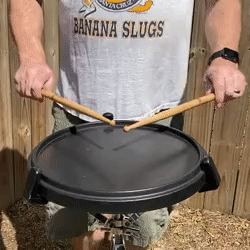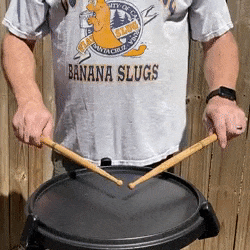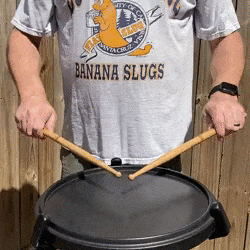FUNdamental Steps
Now that we've gained some comfort with our Legato strokes, we will start to focus on the other three stroke types. The sections that follow will help to explain the approaches to the different strokes in the "Fundamental Steps" exercise below. As always, technique, accuracy, and control should be the focus over speed at this point!
Play the "FUNdamental Steps" exercise along with the recordings provided. When you are comfortable with each tempo, you will be ready to continue to "Fundaments Strokes."
Play the "FUNdamental Steps" exercise along with the recordings provided. When you are comfortable with each tempo, you will be ready to continue to "Fundaments Strokes."
-
TapsTaps are close cousins of Legato strokes. Taps and Legatos are both rebound strokes. However, Tap strokes start and end at three inches above the playing surface. Taps are intended to be low volume strokes, this does not mean that they are low-velocity strokes. Our volume control will come exclusively from stick height. Our velocity-of-stroke should always remain at maximum!

Notice that the last note of the line will be a single Staccato stroke. -
StaccatosHere, we will isolate Staccato strokes. Staccatos will start at a height of 12 inches. But, unlike Legato strokes, the rebound will be controlled to 3 inches. Although this is intended to be a louder stroke type, It is important that we don't pound or force the stick/mallet into the instrument. Instead, let's think about letting gravity take care of the work. Concentrate on dropping the stick from that 12 inch height, and controlling the rebound to 3 inches with zero tension (…or, as close to no tension as humanly possible!)
 [Pro tip: Making sure you keep your pinky and ring fingers in contact with the stick will greatly help your ability to control the rebound][Pro Tip: Be very careful to count all the rests in between the strokes aloud. This is crucial for our ability to maintain tempo as we play!]
[Pro tip: Making sure you keep your pinky and ring fingers in contact with the stick will greatly help your ability to control the rebound][Pro Tip: Be very careful to count all the rests in between the strokes aloud. This is crucial for our ability to maintain tempo as we play!] -
Taps & StaccatosNow that we are controlling the rebound of the Staccato stroke, we can easily add the Taps back into the mix. Play the Taps no higher than 3 inches, and as strongly as possible while staying as relaxed as possible.[Pro tip: Making sure you keep your pinky and ring fingers in contact with the stick will greatly help your ability to control the rebound]
-
Staccatos & UpstrokesHere we add Upstrokes. Be very careful that we don't let the height of the Upstrokes sneak up above 3 inches. The tendency is to turn these strokes into sub-accents. We want to keep the volume to these notes equal to the Taps
 [Pro Tip: Be very careful to count all the rests in between the strokes aloud. This is crucial for our ability to maintain tempo as we play!][Pro tip: Making sure you keep your pinky and ring fingers in contact with the stick will greatly help your ability to control the rebound]
[Pro Tip: Be very careful to count all the rests in between the strokes aloud. This is crucial for our ability to maintain tempo as we play!][Pro tip: Making sure you keep your pinky and ring fingers in contact with the stick will greatly help your ability to control the rebound] -
Taps, Staccatos, & UpstrokesNow, we will simply add taps into what we've already set up. Be very observant of your heights as you play: 12 inches for the Accents and 3 inches for the non-accented notes.[Pro tip: Making sure you keep your pinky and ring fingers in contact with the stick will greatly help your ability to control the rebound]
Open all Close all
